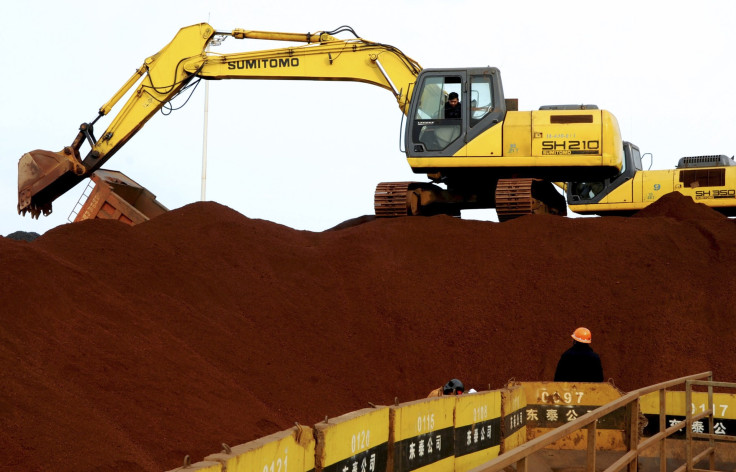Iron Ore, Copper, Oil Prices: Is This The Beginning Of A Global Slowdown, Or Just A Supply Glut?

Oil, copper and iron ore prices continue to fall sharply, raising concerns about a possible downturn in the global economy. The oversupply of oil that led to a 55 percent decline in crude prices since last spring is largely to blame for recent price drops in key energy and mining commodities. Demand has slowed for commodities, as China’s economic growth decelerates and other emerging-market countries face a stronger U.S. dollar.
“China is still growing at a robust pace but continues on a path of gradual deceleration,” the World Bank said in its 2015 forecast released late Tuesday, which lowered its global growth forecast from 3.4 percent to 3 percent for the year. Growth in emerging-market nations slipped, pointing to a slowdown in productivity and dampened growth prospects, the report noted.
Lower commodity prices can be a symptom of a larger problem with the global economy. Economists say weakness in copper, iron ore and oil prices is troubling for the global economy because the commodities are so vital to the industrial production that creates jobs, generating income for consumers who buy big-ticket items made from these raw materials, like cars, washing machines and houses.
Copper prices fell sharply on Wednesday to their lowest since 2009 amid an Asian sell-off that drove the metal’s March delivery price to $2.496 a pound on the New York Mercantile Exchange. The benchmark price of iron ore, a key ingredient in the production of steel, was close to its five-year low on Wednesday, at $68.50 a ton. Meanwhile, Brent crude, the global oil price, fell 12 cents to $45.77 a barrel in London while U.S. oil dropped 52 cents to $46.07.
“It would be wrong to dismiss the possibility that the acceleration in the decline in copper prices is an indication of a sharper downturn in the global economy and especially in China,” Julian Jessop, chief global economist for Capital Economics, said in a Wednesday note to investors, signaling that demand for these raw materials might also be declining in the world’s second-largest economy.
As oil prices trend steadily lower, traders are concerned that falling prices are the result of both too much production and declining demand. Economists are expressing some concern over China, which faces its weakest pace of gross domestic product growth in 24 years, possibly as low as 7 percent, down from more than 10 percent in 2010.
"A slowdown in China would dampen activity in the entire region because of the size of the Chinese market and the close trade and investment links,” M. Ayhan Kose, director of the World Bank Group’s Development Prospects Group, told Australian Broadcasting Corporation on Wednesday. “Since it would likely be associated with commodity price declines, commodity exporters would suffer a double blow."
A significant factor in all of this has been the cost of the U.S. dollar. When the dollar is weaker, it tends to flow into emerging markets, fueling demand for industrial commodities. As the dollar strengthens, the flow reverses, lowering demand. Julien Garran, an analyst at UBS, points out that over the past 30 years copper demand has jumped more than 5 percent during years when more capital flows into emerging markets. Copper demand increases by less than 2 percent in years when the flow of investment goes back to developed markets.
Over the past six months, the Dow Jones U.S. Dollar Index, which tracks the strength of the currency, has gained almost 12 percent, making it more expensive for emerging markets to buy dollar-denominated commodities like the materials used in industrial production. At the same time, the growth rate of industrial activity in emerging markets is slowing. The U.S. Fed’s decision not to extend its monetary policy of quantitative easing (also known as printing money to make the dollar cheaper and spur economic activity) in mid-2011 got the ball rolling toward this bearish commodities market. Meanwhile, producers continued to boost supply.
Garran said in a research note on Tuesday that a weaker dollar, easy credit and rising commodity prices in recent years led to a stockpiling of commodities. Now producers have too much supply, which is driving down prices. But Garran says the supply glut will actually be a good thing for manufacturers this year.
“The consensus in markets is that supply caused the collapses in oil and iron ore prices in 2014. And because it was a supply issue, the impact will be positive for global growth,” he said.
What this boils down to is: Emerging-market demand for these raw materials has fallen because of a stronger dollar, while suppliers continues to make the materials, creating a supply glut. How this will affect the global economy in 2015 has yet to be seen, and it explains why economists continue to watch China, the largest purchaser of raw industrial materials, to see how it manages its slowdown.
© Copyright IBTimes 2024. All rights reserved.




















